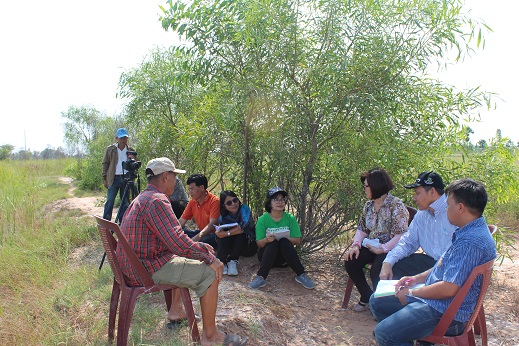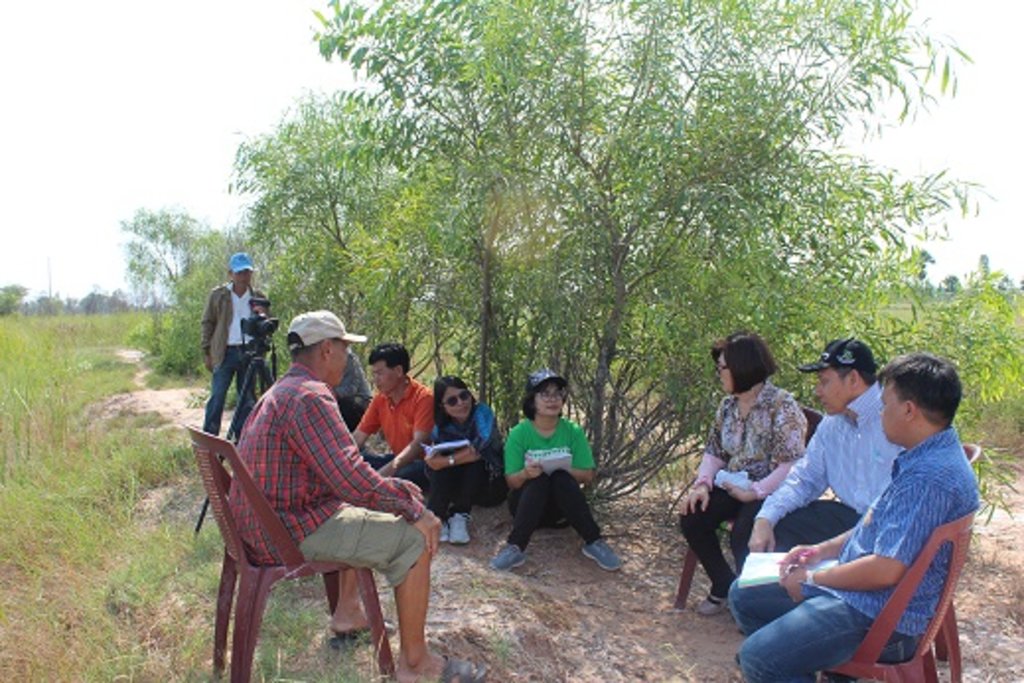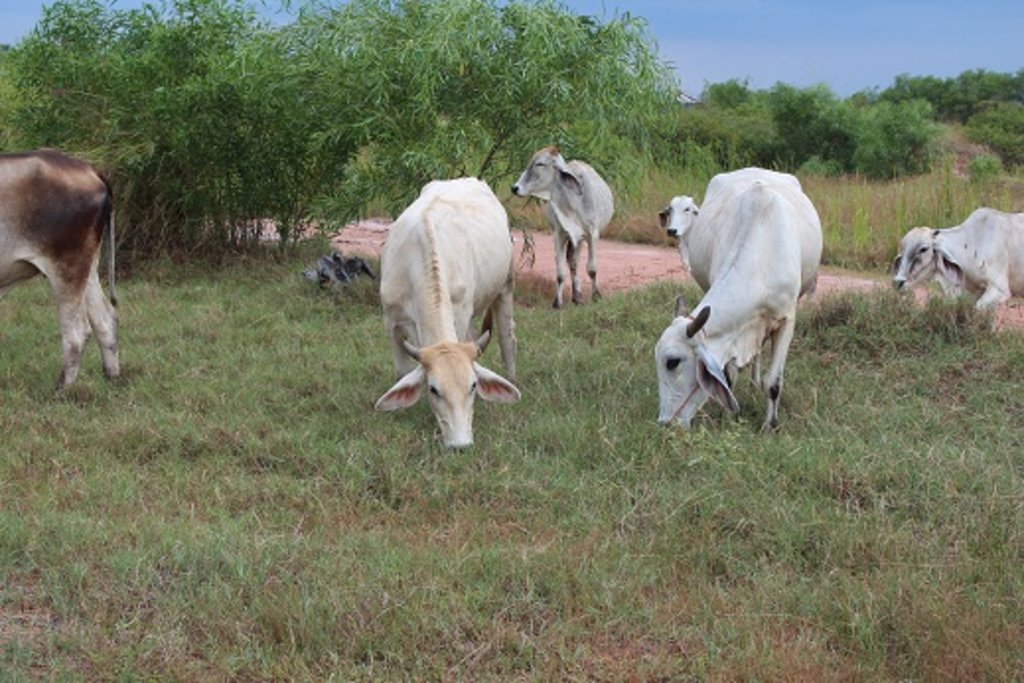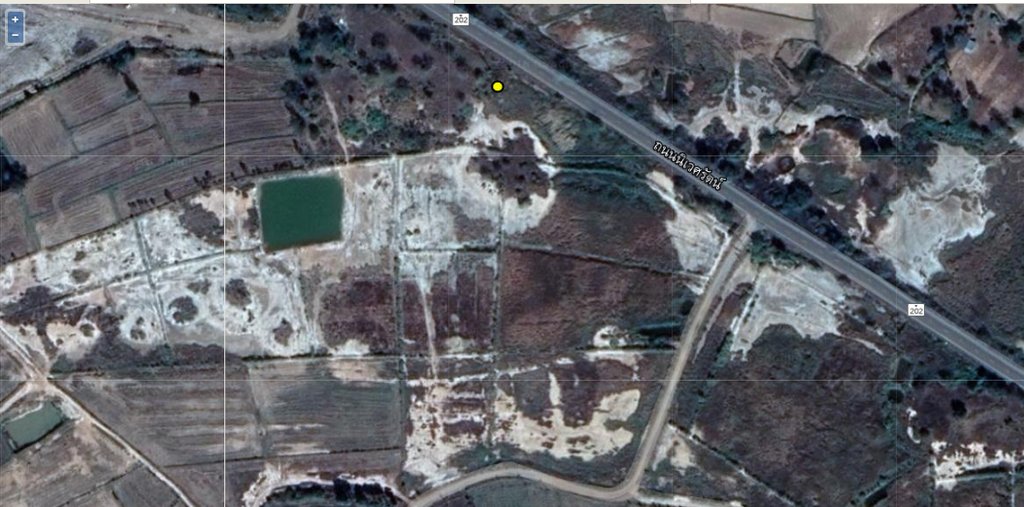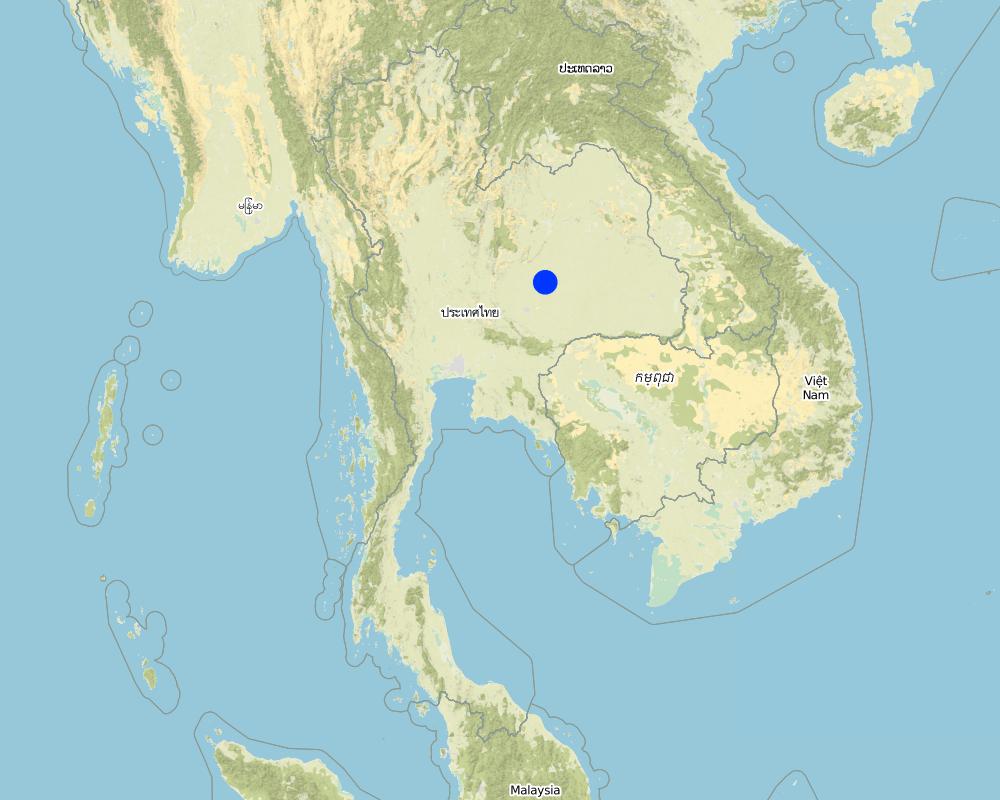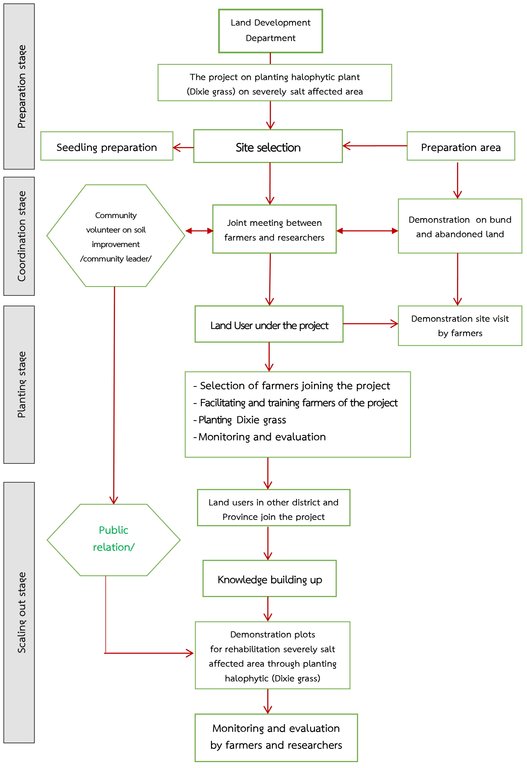Vegetative approach by using halophyte (Dixie grass) to control severely salt-affected land. [ไทย]
- ผู้สร้างสรรค์:
- การอัพเดท:
- ผู้รวบรวม: Kamontip Sasithorn
- ผู้เรียบเรียง: –
- ผู้ตรวจสอบ: Samran Sombatpanit, Rima Mekdaschi Studer, Alexandra Gavilano
approaches_4210 - ไทย
ดูส่วนย่อย
ขยายทั้งหมด ย่อทั้งหมด1. ข้อมูลทั่วไป
1.2 รายละเอียดที่ติดต่อได้ของผู้รวบรวมและองค์กรที่เกี่ยวข้องในการประเมินและการจัดเตรียมทำเอกสารของแนวทาง
วิทยากรหลัก
ผู้ใช้ที่ดิน:
Yooburi Somsak
+66-80-7240599
10 Moo 12, Ban Kut Chok, Kut Chok Sub-district, Buayai District, Nakhon Ratchasima Province 30120
ไทย
ผู้ใช้ที่ดิน:
Sriwootpong Rungariam
+66-93-4613289
107 Ban Donpae Moo 8, Kut Chok Sub-district, Buayai District, Nakhon Ratchasima Province
ไทย
Department of Agricultural Extension officer:
Auonpokang Chiwat
+66-85-7783258
Buayai District Agricultural Extension Office
49 Buayai Sub-district, Buayai District, Nakhon Ratchasima Province 30120
ไทย
ผู้ใช้ที่ดิน:
Kumtisong Noorian
+66-62-1524591
45 Moo 10, Dang-chang Sub-district, Buayai District, Nakhon Ratchasima Province 30120
ไทย
ผู้เชี่ยวชาญ SLM:
ผู้เชี่ยวชาญ SLM:
ผู้เชี่ยวชาญ SLM:
ผู้เชี่ยวชาญ SLM:
National consultant:
ชื่อของโครงการซึ่งอำนวยความสะดวกในการทำเอกสารหรือการประเมินแนวทาง (ถ้าเกี่ยวข้อง)
Book project: where the land is greener - Case Studies and Analysis of Soil and Water Conservation Initiatives Worldwide (where the land is greener)ชื่อของโครงการซึ่งอำนวยความสะดวกในการทำเอกสารหรือการประเมินแนวทาง (ถ้าเกี่ยวข้อง)
Book project: where the land is greener - Case Studies and Analysis of Soil and Water Conservation Initiatives Worldwide (where the land is greener)ชื่อของโครงการซึ่งอำนวยความสะดวกในการทำเอกสารหรือการประเมินแนวทาง (ถ้าเกี่ยวข้อง)
Land Development Department LDD (Land Development Department LDD) - ไทย1.3 เงื่อนไขที่เกี่ยวข้องกับการใช้ข้อมูลที่ได้บันทึกไว้ผ่านทาง WOCAT
วันที่เก็บรวบรวมข้อมูล (ภาคสนาม):
18/10/2018
ผู้รวบรวมและวิทยากรหลักยอมรับเงื่อนไขเกี่ยวกับการใช้ข้อมูลที่ถูกบันทึกผ่านทาง WOCAT:
ใช่
1.4 การอ้างอิงถึงแบบสอบถามเรื่องเทคโนโลยี SLM
2. คำอธิบายของแนวทาง SLM
2.1 การอธิบายแบบสั้น ๆ ของแนวทาง
The government promotes halophytes (Dixie grass) to control severely salt-affected land, rehabilitate the ecosystem and prevent the spread of salt in soil under cooperation of land owners, livestock farmers, local administration, local government agency, Land Development Department researchers and with specialists/ technical advisors in various fields.
2.2 การอธิบายอย่างละเอียดของแนวทาง
การอธิบายอย่างละเอียดของแนวทาง:
Ministry of Agriculture and Cooperatives by Land Development Department (LDD) had initiated the project on planting salt-tolerant tree and grass on severely salt-affected land in the Northeast of Thailand since 1996. The project had facilitated planting halophyte (Dixie grass) on salt-crusted and barren land since then. The main objectives of approach were to promote the land users to maximize land use for farming, prevent the forming of extensive severely saline soil, to use halophyte (Dixie grass) as cover crop and rehabilitate the ecosystem of severely salt-affected soil. The activities started with public hearing, identifying severely salt-affected areas, set demonstration plot on the farmer’s land as learning center and communication with local administration to call for farmers meeting with detailed work plan and discussion of strengths, weaknesses, opportunities, and threats of planting Dixie grass. The implementing activities consisted of 4 stages; the PREPARATION STAGE was for seedling preparation, site selection of severely salt-affected soil and land preparation, public hearing and establishment of the demonstration plot at Dan Chang Sub-district, Buayai District, Nakhon Ratchasima Province. The COORDINATION STAGE included joint meeting between farmers and researchers, joint monitoring & evaluation and follow up and land users' decision-making. The PLANTING STAGE started from selection of farmers joining the project, facilitating and training farmers, site visit to the demonstration plot, which is the model of planting method established under the project on planting salt-tolerant tree and grass on severely salt-affected land in the Northeast of Thailand. The FINAL ACTIVITY OF SCALING-OUT STAGE: the land users/ farmers favoured this project; after 3 years of planting Dixie grass it was found this barren land became covered by plants and much improved in biodiversity by the evidence of many varieties of wild grasses and flowers, dragonflies, rats and birds. Farmers could now grow rice and they used Dixie grass as feed for livestock. Moreover, and attractively, farmers were able to increase their income. The migration for job to big cities was reduced. The stakeholders were land owners, livestock farmers, local administration, local government agency, researchers and SML specialists from LDD - all worked together with mutual benefit. Although planting halophytes was an improvement method (of vegetative measure) of severely saline soil with low input, the recovery/accomplishment time (in saline soil improvement) could not be as fast as that of the engineering measure with much higher investment.
2.3 รูปภาพของแนวทาง
2.4 วีดีโอของแนวทาง
วันที่:
18/10/2018
สถานที่:
6 Ban Donpae Moo 8, Kut Chok Sub-district, Buayai District, Nakhon Ratchasima Province
2.5 ประเทศ ภูมิภาค หรือสถานที่ตั้งที่ได้นำแนวทางไปใช้
ประเทศ:
ไทย
ภูมิภาค/รัฐ/จังหวัด: :
Nakhon Ratchasima Province
ข้อมูลเฉพาะเพิ่มเติมของสถานที่ตั้ง:
6 Ban Donpae Moo 8, Kut Chok Sub-district, Buayai District
Map
×2.6 วันที่เริ่มต้นและสิ้นสุดของแนวทาง
ระบุปีที่เริ่ม:
2015
การสิ้นสุดลง (ถ้าแนวทางไม่ได้ใช้อีกต่อไป):
2016
2.7 ประเภทของแนวทาง
- ใช้โครงงานหรือแผนงานเป็นฐาน
2.8 เป้าหมายหรือวัตถุประสงค์หลักของแนวทาง
The main objectives of the approach were to promote the land users to maximize land use for farming, to prevent the forming of extensive severely saline soil, to use halophyte (Dixie grass) as cover crop and to rehabilitate the ecosystem of severely salt-affected soil.
2.9 เงื่อนไขที่เอื้ออำนวยหรือเป็นอุปสรรคต่อการนำเทคโนโลยีภายใต้แนวทางนี้ไปปฏิบัติใช้
บรรทัดฐานและค่านิยมทางสังคม วัฒนธรรม ศาสนา
- เอื้ออำนวย
The land users follow what their neighbours practice.
การมีไว้ให้หรือการเข้าถึงแหล่งการเงินและบริการ
- เอื้ออำนวย
Through the Bank for Agriculture and Agricultural Cooperatives.
การจัดตั้งระดับองค์กร
- เอื้ออำนวย
Local administration
การร่วมมือหรือการทำงานประสานกันของผู้ลงมือปฏิบัติ
- เอื้ออำนวย
Coordination of soil doctor volunteers and community leaders in the area.
นโยบาย
- เอื้ออำนวย
The government has the policy to prevent soil degradation.
ความรู้เกี่ยวกับ SLM การเข้าถึงการสนับสนุนด้านเทคนิค
- เอื้ออำนวย
To provide knowledge to land users in the area.
ปริมาณงานที่ทำได้ กำลังคนที่มีให้
- เอื้ออำนวย
For land users under the project
- เป็นอุปสรรค
For land users outside the project
3. การมีส่วนร่วมและบทบาทของผู้มีส่วนได้ส่วนเสียที่เกี่ยวข้อง
3.1 ผู้มีส่วนได้ส่วนเสียที่เกี่ยวข้องในแนวทางนี้และบทบาท
- ผู้ใช้ที่ดินระดับท้องถิ่นหรือชุมชนระดับท้องถิ่น
Farmers under the project
Planting halophytes (Sporobolus verginicus - Dixie grass)
- องค์กรที่ขึ้นอยู่กับชุมชน
Local administration (Sub-district Administration Organization)
Call for meeting
- ผู้เชี่ยวชาญ SLM หรือที่ปรึกษาการเกษตร
Land Development Department
Site selection
- นักวิจัย
Land Development Department
Provide technical recommendations
- รัฐบาลแห่งชาติ (ผู้วางแผน ผู้ทำการตัดสินใจ)
Land Development Department
Funding, planner, decision-makers
3.2 การเกี่ยวข้องของผู้ใช้ที่ดินระดับท้องถิ่นหรือชุมชนระดับท้องถิ่นในช่วงต่างๆของแนวทาง
| ความเกี่ยวข้องของผู้ใช้ที่ดินระดับท้องถิ่นหรือชุมชนระดับท้องถิ่น | ระบุผู้ที่มีส่วนเกี่ยวข้องและอธิบายกิจกรรม | |
|---|---|---|
| การริเริ่มหรือการจูงใจ | ปฏิสัมพันธ์ | Land users in the project based |
| การวางแผน | ไม่ลงมือ | Discussion with land users on work plan before starting the activity. |
| การดำเนินการ | จ่ายเงินหรือสนับสนุนจากภายนอก | Land users/farmers in the project |
| การติดตามตรวจสอบหรือการประเมินผล | จ่ายเงินหรือสนับสนุนจากภายนอก | Land users in the project |
3.3 แผนผังแสดงขั้นตอนการทำงาน (ถ้ามี)
คำอธิบาย:
Four stages of participating process of technology development among organizations, community volunteers on soil improvement, farmers, SML specialists and researchers.
ผู้เขียน:
Kamontip Sasithorn
3.4 การตัดสินใจเลือกใช้เทคโนโลยี SLM
ระบุผู้ที่ทำการตัดสินใจเลือกเทคโนโลยีมากกว่าหนึ่งวิธีไปปฏิบัติใช้:
- ผู้เชี่ยวชาญ SLM เป็นผู้ตัดสินใจหลัก ที่ติดตามให้คำปรึกษากับผู้ใช้ที่ดิน
ระบุว่าการตัดสินใจตั้งอยู่บนพื้นฐานของ:
- การประเมินความรู้ SLM ที่ได้ทำการบันทึกไว้เป็นอย่างดี (การใช้ข้อมูลในการตัดสินใจ)
4. การสนับสนุนด้านเทคนิค การสร้างขีดความสามารถ และการจัดการด้านความรู้
4.1 การสร้างขีดความสามารถ / การอบรม
ได้มีการจัดอบรมให้แก่ผู้ใช้ที่ดินหรือผู้มีส่วนได้ส่วนเสียคนอื่น ๆ หรือไม่:
ใช่
ให้ระบุว่าใครเป็นผู้ได้รับการอบรม:
- ผู้ใช้ที่ดิน
รูปแบบการอบรม:
- ใช้พื้นที่ทำการสาธิต
- จัดการประชุมสู่สาธารณชน
หัวข้อที่พูด:
Prevention and rehabilitation of salt-affected land with available technology and increased income for farmers.
4.2 การบริการให้คำแนะนำ
ผู้ใช้ที่ดินมีการเข้าถึงการรับบริการให้คำปรึกษาหรือไม่:
ใช่
ระบุว่ามีบริการให้คำปรึกษาหรือไม่:
- ไปเยี่ยมชมสถานที่
การอธิบาย/แสดงความคิดเห็น:
1. Soil doctor volunteers represent the Land Development Department with duty in providing knowledge to farmers in the area.
2. SLM specialists from Land Development Department visited and advised farmers in the area.
4.3 การเสริมความแข็งแกร่งให้กับสถาบัน (การพัฒนาองค์กร)
สถาบันได้รับการจัดตั้งขึ้นมาหรือเสริมความแข็งแกร่งโดยแนวทางนี้หรือไม่:
- ไม่
4.4 การติดตามตรวจสอบและประเมินผล
การติดตามตรวจสอบและประเมินผลเป็นส่วนหนึ่งของแนวทางหรือไม่:
ใช่
ความคิดเห็น:
SLM specialists from Land Development Department collaborated with LDD soil doctor volunteers in surveying the survival rate and following up the growth of plants in the area.
ถ้าตอบว่าใช่ แสดงว่าการจัดเตรียมเอกสารนี้มุ่งหวังที่จะเอาไปใช้สำหรับการติดตามตรวจสอบและประเมินผลใช่หรือไม่:
ใช่
4.5 การวิจัย
การวิจัยเป็นส่วนหนึ่งของแนวทางหรือไม่:
ใช่
ระบุหัวข้อเรื่อง:
- เทคโนโลยี
ให้ข้อมูลเพิ่มเติมและให้ระบุผู้ทำการวิจัย:
The Soil Salinity Research Group, LDD, conducted research on "halophytes plantation and the flow path along the landscape in Northeast Thailand" with Dr. J.L. Gallagher from Delaware Biotechnology Institute, University of Delaware.
5. การสนับสนุนด้านการเงินและวัสดุอุปกรณ์
5.1 ระบุงบประมาณประจำปีสำหรับแนวทาง SLM นี้
ถ้าหากว่างบประมาณประจำปีไม่เป็นที่ทราบแน่นอน ให้ระบุช่วงลงไป:
- < 2,000
แสดงความคิดเห็น (แหล่งของการระดมทุน ผู้บริจาคคนสำคัญ):
Land Development Department
5.2 การสนับสนุนด้านการเงิน / วัสดุอุปกรณ์ให้แก่ผู้ใช้ที่ดิน
ผู้ใช้ที่ดินได้รับการสนับสนุนด้านการเงิน / วัสดุอุปกรณ์ไปปฏิบัติใช้เทคโนโลยีหรือไม่:
ใช่
ถ้าใช่ ให้ระบุประเภทของการสนับสนุน เงื่อนไขและผู้จัดหามาให้:
Dixie grass seedlings and land preparation cost
5.3 เงินสนับสนุนสำหรับปัจจัยนำเข้า (รวมถึงแรงงาน)
- แรงงาน
| เห็นด้วยระดับไหน | ระบุเงินสนับสนุน |
|---|---|
| ได้รับการช่วยเหลือทางการเงินแบบเต็ม | Planting |
- อื่น ๆ
| อื่นๆ (ระบุ) | เห็นด้วยระดับไหน | ระบุเงินสนับสนุน |
|---|---|---|
| seeding | ได้รับการช่วยเหลือทางการเงินแบบเต็ม | free seedings |
ถ้าแรงงานโดยผู้ใช้ที่ดินเป็นปัจจัยนำเข้าที่มีอยู่มากมาย ระบุด้วยว่าเนื่องจาก:
- จ่ายเป็นเงินสด
ความคิดเห็น:
Labour by land users and employees; due to the landowner has insufficient labor for grass planting. Therefore, need to hire workers to grow by paying wages a day 175 THB/person (the minimum rate)
5.4 เครดิต
มีการจัดหาเครดิตมาให้ภายใต้แนวทาง SLM หรือไม่:
ไม่ใช่
5.5 แรงจูงใจหรือเครื่องมืออื่น ๆ
แรงจูงใจหรือเครื่องมืออื่น ๆ ได้ถูกนำไปใช้ส่งเสริมการใช้เทคโนโลยี SLM หรือไม่:
ไม่ใช่
6. การวิเคราะห์ผลกระทบและการสรุป
6.1 ผลกระทบของแนวทาง
ทำให้ผู้ใช้ที่ดินระดับท้องถิ่นมีอำนาจขึ้น ปรับปรุงการเข้าร่วมของผู้มีส่วนได้ส่วนเสียให้ดีขึ้นหรือไม่:
- ไม่ใช่
- ใช่ เล็กน้อย
- ใช่ ปานกลาง
- ใช่ อย่างมาก
Generate food security and family income.
ช่วยในการตัดสินใจโดยดูจากหลักฐาน ได้หรือไม่:
- ไม่ใช่
- ใช่ เล็กน้อย
- ใช่ ปานกลาง
- ใช่ อย่างมาก
Establish learning center for farmers as an information for technology adoption.
ช่วยให้ผู้ใช้ที่ดินนำเอาเทคโนโลยี SLMไปใช้และบำรุงรักษาสภาพไว้ได้หรือไม่:
- ไม่ใช่
- ใช่ เล็กน้อย
- ใช่ ปานกลาง
- ใช่ อย่างมาก
Farmers well adopted the technology, resulting in the expansion of such Approach to a wider area.
ปรับปรุงความรู้และความสามารถของผู้ใช้ที่ดินในการดำเนินการ SLM หรือไม่:
- ไม่ใช่
- ใช่ เล็กน้อย
- ใช่ ปานกลาง
- ใช่ อย่างมาก
Farmers have adapted and changed SLM model to suit their own preference.
นำไปสู่ความมั่นคงด้านอาหารหรือปรับปรุงโภชนาการให้ดีขึ้น:
- ไม่ใช่
- ใช่ เล็กน้อย
- ใช่ ปานกลาง
- ใช่ อย่างมาก
Farmers can grow rice and they use Dixie grass as feed for livestock.
นำไปสู่โอกาสในการจ้างงาน รายได้หรือไม่:
- ไม่ใช่
- ใช่ เล็กน้อย
- ใช่ ปานกลาง
- ใช่ อย่างมาก
The migration for job to big cities has reduced.
6.2 แรงจูงใจหลักของผู้ใช้ที่ดินเพื่อที่จะนำ SLM ไปปฏิบัติใช้
- การผลิตที่เพิ่มขึ้น
From the interview, farmers were satisfied with this technology of Sporobolus virginicus planting to rehabilitate severely saline soil. Besides being lower in salination farmers got more rice yields and better environment and livelihoods.
- การเสื่อมของที่ดินลดลง
After 3 years of planting Dixie grass, it was found that the formerly barren land became covered by plants and much improved in biodiversity by the evidence of many varieties of wild grass, dragonflies, rats and birds.
6.3 ความยั่งยืนของกิจกรรมของแนวทาง
ผู้ใช้ที่ดินสามารถทำให้สิ่งต่างๆ ที่ได้ปฏิบัติใช้โดยแนวทางนี้ยั่งยืนได้หรือไม่ (โดยไม่มีการสนับสนุนจากภายนอก):
- ใช่
ถ้าตอบว่าใช่ ให้อธิบายว่าอย่างไร :
Farmers have better understanding and positive attitude of planting halophytes (Dixie grass). Moreover, they have more income generated from rice yield and livestocks, as farmers could now grow rice and used Dixie grass to raise livestock.
6.4 จุดแข็งและข้อได้เปรียบของแนวทาง
| จุดแข็ง / ข้อได้เปรียบของแนวทางในทัศนคติของผู้ใช้ที่ดิน |
|---|
| Soil doctor volunteer, local government agency and community leader were the coordinators in the area. |
| Farmers had easy access to markets and sources of Dixie grass seedlings. |
| Distribution of Dixie grass seedling was done at no cost. |
| จุดแข็ง / ข้อได้เปรียบของแนวทางในทัศนคติของผู้รวบรวมหรือวิทยากรหลัก |
|---|
| A supported technique created to make better environment on severely saline soil in the Northeast of Thailand. |
| Technique in planting Dixie grass was provided continually by Land Development Department and community volunteers on soil improvement. |
| A demonstrated plot was established in the area. |
6.5 จุดอ่อน / ข้อเสียเปรียบของแนวทางและวิธีในการแก้ไข
| จุดอ่อน / ข้อเสียเปรียบในทัศนคติของผู้ใช้ที่ดิน | สามารถแก้ไขปัญหาได้อย่างไร |
|---|---|
| Advertising of project was not extensive enough, particularly to the area of severely saline soil. | It is necessary for the Land Development Department to cooperate more closely with local administration to promote the project. |
| จุดอ่อน / ข้อเสียเปรียบในทัศนคติของผู้รวบรวมหรือวิทยากรหลัก | สามารถแก้ไขปัญหาได้อย่างไร |
|---|---|
| Some farmers did not believe that Dixie grass was very salt tolerant and will make the salinity of the soil decrease after planting it. | The officers should build up knowledge from successful farmers by frequently visiting farmers in the area under the project "rehabilitation of severely salt-affected soil by planting Dixie grass". |
7. การอ้างอิงและการเชื่อมต่อ
7.1 วิธีการหรือแหล่งข้อมูล
- การสัมภาษณ์กับผู้ใช้ที่ดิน
- การสัมภาษณ์ผู้เชี่ยวชาญด้าน SLM หรือผู้ชำนาญ
7.2 การอ้างอิงถึงสิ่งตีพิมพ์
ชื่อเรื่อง ผู้เขียน ปี ISBN:
Land Development Department
ช่องทางในการสืบค้น และราคา:
http://www.ldd.go.th/
7.3 เชื่อมโยงกับข้อมูลที่มีอยู่บนออนไลน์
ชื่อเรื่องหรือคำอธิบาย:
where the land is greener - Case Studies and Analysis of Soil and Water Conservation Initiatives Worldwide
URL:
https://www.wocat.net/library/media/27/
ชื่อเรื่องหรือคำอธิบาย:
where people and their land are safer - A Compendium of Good Practices in Disaster Risk Reduction (DRR) (where people and their land are safer) URL:
URL:
https://www.wocat.net/en/projects-and-countries/projects/drr
ลิงก์และโมดูล
ขยายทั้งหมด ย่อทั้งหมดลิงก์
ไม่มีลิงก์
โมดูล
ไม่มีโมดูล


